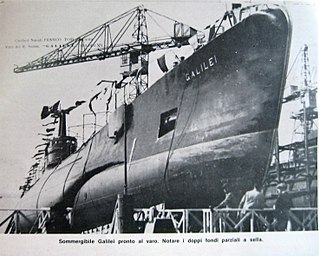
The Regia Marina was the navy of the Kingdom of Italy from 1861 to 1946. In 1946, with the birth of the Italian Republic, the Regia Marina changed its name to Marina Militare.

Galileo Galilei was one of four Archimede-class submarines built for the Regia Marina during the early 1930s. She was named after Galileo Galilei, an Italian astronomer and engineer.

The Redoutable-class submarines were a group of 31 submarines built between 1924 and 1937 for the French Navy. Most of the class saw service during the Second World War. The class is also known in French as the Classe 1 500 tonnes, and they were designated as "First Class submarines", or "large submarine cruisers". They are known as the Redoutable class in reference to the lead boat Redoutable, in service from 1931 to 1942. The class is divided into two sub-class series, Type I, known as Le Redoutable and Type II, Pascal.

The Archimede class were a group of four submarines built for the Regia Marina in the early 1930s. The boats fought in the Spanish Civil War and in World War II. Under Spanish colors, these boats were known as the General Mola class, and remained in service until 1959.
Several ships of the Royal Navy have borne the name HMS Cachalot, after the marine mammal, the cachalot, or sperm whale:
The Italian submarine fleet of World War II was the largest in the world at the time, with 116 submarines. It saw action during the Second World War, serving mainly in the Mediterranean. During the conflict 88 submarines, some two-thirds of its total strength, were lost.
Archimede is the French and Italian form of Archimedes. It may also refer to:
Archimede was a Brin-class submarine built for the Royal Italian Navy during the 1930s.
Guglielmo Marconi was the name of at least two ships of the Italian Navy named in honour of Guglielmo Marconi and may refer to:
The Cantieri navali Tosi di Taranto is a defunct Italian shipyard founded in 1914 by engineering company Franco Tosi & C. Between World War I and World War II it specialized in building submarines. The company never really recovered from the devastation from World War II and it was one of the first acquisitions of the newly formed financial holding company, Fincantieri, on 29 December 1959. The shipyard closed on 31 December 1990.

The Škoda 10 cm K10 was a 100 mm (3.9-inch) naval gun of the Austro-Hungarian Navy used as tertiary armament on semi-dreadnought battleships and as primary armament on scout cruisers and destroyers during World War I. After World War I, variants of the Škoda 10 cm K10 were widely produced in Italy as the 100/47 series of guns, which served in a number of roles, on a wide variety of ships, with a number of navies.
Guglielmotti was a Brin-class submarine built for the Royal Italian Navy during the 1930s.
Nereide was the name of at least two ships of the Italian Navy and may refer to:
Leonardo da Vinci this name has been borne by at least four ships of the Italian Navy and may refer to:
Evangelista Torricelli or just Torricelli was the name of at least four ships of the Italian Navy and may refer to:
Galileo Ferraris was the name of at least two ships of the Italian Navy and may refer to:
Alfredo Cappellini or Comandante Cappellini was the name of at least three ships of the Italian Navy named in honour of Alfredo Cappellini and may refer to:
Archimede was the lead ship of her class of four submarines built for the Regia Marina during the early 1930s. She was transferred to the Armada Española of Nationalists in 1937, renamed General Sanjuro, and served in the Spanish Civil War of 1936–1939.
Evangelista Torricelli was one of four Archimede-class submarines built for the Regia Marina during the 1930s. She served in the Spanish Civil War of 1936–1939, and was transferred to the Armada Española of Nationalists in 1937, renamed as General Mola.
Galileo Ferraris was one of four Archimede-class submarines built for the Regia Marina during the early 1930s. She played a minor role in the Spanish Civil War of 1936–1939 supporting the Spanish Nationalists.
This page is based on this
Wikipedia article Text is available under the
CC BY-SA 4.0 license; additional terms may apply.
Images, videos and audio are available under their respective licenses.




